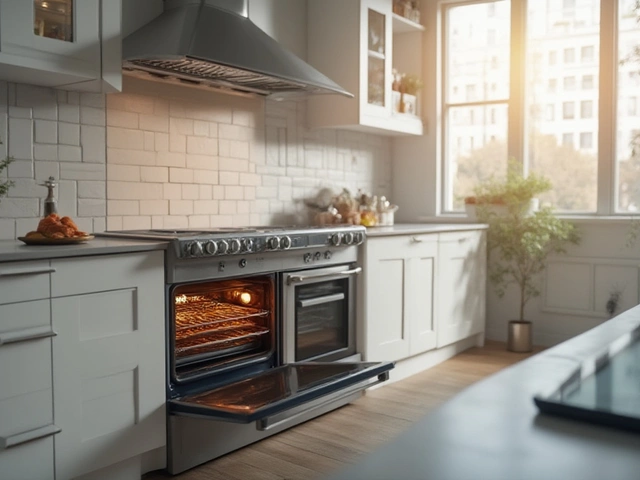If your kitchen smells like yesterday’s dinner, it’s probably time to replace the extractor fan. A good fan pulls steam, smoke, and odors out of the room, keeping things fresh and safe. The good news? Swapping it out is a job most homeowners can do in an afternoon with just a few tools.
Gather these basics so the job runs smoothly:
Turn off the power at the breaker before you touch any wires – safety first.
1. Remove the old fan. Unscrew the front grill, then detach the fan housing from the cabinet. Most units are held by a couple of screws and a simple mounting bracket.
2. Disconnect the wiring. You’ll see a short cord with three wires – live, neutral, and earth. Loosen the wire nuts, separate the wires, and cap them with electrical tape.
3. Take out the old motor. Lift the motor assembly out of the vent pipe. If the pipe is glued, gently twist to loosen it. Keep the old fan nearby so you can compare sizes.
4. Prepare the new fan. Match the new fan’s mounting holes with the cabinet. Some models come with a universal bracket; attach it if needed.
5. Connect the new wiring. Match the live (brown), neutral (blue), and earth (green/yellow) wires and secure them with fresh wire nuts. Double‑check that the connections are tight.
6. Install the fan. Slide the new motor into the vent pipe, align the mounting bracket, and screw everything back into place. Make sure the fan sits flush against the cabinet to avoid rattles.
7. Test it. Turn the breaker back on and switch the fan on. You should hear a steady hum and feel airflow through the vent. If it’s quiet or doesn’t spin, double‑check the wiring and the motor’s orientation.
Cleaning the fan’s blades and the vent pipe every few months will keep it running efficiently.
If at any point the wiring looks damaged, the vent pipe is corroded, or the fan doesn’t match the old size, it’s wise to call an appliance repair professional. A qualified technician can handle complex wiring, ensure the fan meets local building codes, and avoid costly mistakes.
Replacing an extractor fan isn’t rocket science, but it does need a bit of patience and attention to detail. With the right tools and this guide, you can get your kitchen breathing again without waiting for a service call.

Wondering how often you should replace your extractor fan? This article covers extractor fan lifespan, signs it's time for a change, maintenance tips, and why fresh air matters.

Thinking about swapping out your old extractor fan? This guide digs into how easy (or not) it really is to replace an extractor fan in your bathroom or kitchen. Get the lowdown on what tools you'll need, common surprises people miss, and what makes some fans trickier than others. If you're not sure when to call in a pro, we've got your back there, too. Get ready for a clear, no-nonsense breakdown.

Replacing an extractor fan might seem challenging, but with the right tools and some guidance, it can be done efficiently. This guide outlines the process of replacing an extractor fan, from identifying signs it needs replacement to understanding how to choose the right model. Learn practical tips for handling installation and maintaining safety during the project. Make this task more approachable with easy-to-follow steps designed for beginners.

Discover practical solutions to restore hot water in your shower with ease. Learn about common problems affecting water heaters and the steps to troubleshoot each issue. This guide will walk you through changing settings, checking components, and knowing when to call a pro. Take control of your hot water system and enjoy a soothing shower experience once again. Ideal for homeowners facing frustrating lukewarm showers.

Refrigerators are a crucial part of our daily lives, and when they malfunction, it can be a real headache. One of the most common repairs involves fixing the refrigerator's cooling system. Often, issues arise from problems with the condenser coils, which can become dirty or worn out over time. By understanding these common problems, homeowners can better maintain their appliances, potentially saving time and money.

Need to replace your electric oven element? Find out how much it costs, what affects the price, and the best options for repairing your oven in 2025.

Ovens are essential in any kitchen, but they can sometimes act up. Whether it's uneven cooking, a door that won't close, or strange noises, there's usually a straightforward explanation—and solution. This article delves into typical oven issues, offers handy tips to troubleshoot them, and suggests when it's time to call a professional. Knowing these basics can help keep your oven running smoothly.

Navigating the world of cooker repair can seem daunting, but armed with the right knowledge, it becomes manageable. This article explores common issues faced by cookers, signs that suggest whether repair is possible, and steps on how to approach fixing these vital kitchen appliances. By identifying whether a do-it-yourself fix is feasible or when to call in a professional, you can make informed decisions about your cooker. Learn about maintenance tips to prolong the life of your cooker and keep it working efficiently.